Young dancers will soon have the opportunity to access both world-class training and a top-notch high school education, thanks to a new nonprofit partnership in the Greater Boston area. Boston Ballet School and Walnut Hill School for the Arts have teamed up to create the Boston Ballet School’s Professional Division at Walnut Hill. The program combines the ballet school’s pre-professional dance training with the residential academic program of Walnut Hill, a renowned and highly competitive arts high school in Natick, Massachusetts.
The program is the first in the United States to combine a residential and pre-college preparatory program with pre-professional dance training. Set to launch in fall 2020, the goal is to prepare students for ballet careers as well as a life outside of the dance world.
We recently talked with Max Hodges, Executive Director of Boston Ballet, and Antonio Viva, Head of School for Walnut Hill, about how the program benefits their organizations and dance students alike. They also shared valuable guidance for creating successful nonprofit partnerships.
It became clear to us that we had the unique opportunity to do something even better together.
What prompted the idea of partnering to create the new professional division program?
Max Hodges: We were at a point where the growth in our pre-professional program was strong, and we were increasingly recruiting students from outside of New England. But we were experiencing challenges in meeting the full suite of our students’ needs. In addition to the pre-professional training, they need support, including college prep academics and, if they were coming from outside the area, places to live. Our students were making it work by taking online classes and living in apartments. But we knew we could offer something more.
Antonio Viva: For us, we’d just completed some work on how we could better partner with other arts organizations and make those resources available to our students. We’ve been two programs that have competed for students at times, with both organizations putting amazing, talented dancers into the world. It became clear to us that we had the unique opportunity to do something even better together. It gave both Walnut Hill and Boston Ballet School the chance to differentiate themselves.
What are your joint goals for the partnership?
Viva: We want to be the preeminent pre-professional dance program in the country. We want to put dancers into the world that are artistically and creatively prepared to contribute to the evolution of dance for many decades to come.
Hodges: I agree with all of that. I’ll add that we also want our graduates to graduate into Boston Ballet as well.
The program description notes the importance of providing an education for the whole dancer. Can you discuss what that means?
Hodges: We want to prepare our students for life in professional ballet and for their lives after professional ballet. A dancer’s career is brilliant and dream fulfilling, but it can be very short, and it’s possible to have a career-ending injury. We want our dancers to be prepared for any career path, not only dance.
Viva: We’ve been doing this for 35 years, and we don’t think of our students just as artists in their specific discipline. There are three things that make up a person: body, mind and spirit. We want to provide comprehensive wellness programming and opportunities for our artists to meet and learn from artists in other disciplines. Living and working together and giving them the space to be creative in multiple ways provides a rich and deep school experience.
How have the board and other stakeholders come into play throughout this process?
Hodges: With the Walnut Hill partnership, the school committee of the Boston Ballet School Board was instrumental. We also thought about how each constituency would be impacted, the questions they would have and any concerns. We wanted the board’s buy-in as well as the buy-in from our families and students.
Viva: The challenge with any kind of new initiative is that folks have lots of questions. You want to make room for opportunities to provide answers. Our board was heavily involved.
As you’ve embarked on this initiative, what have you learned about creating effective partnerships between two nonprofits?
Hodges: It’s absolutely critical that it’s rooted in meeting your nonprofit mission objectives — that’s the reason to pursue a partnership for both parties. For example, we’re coming together to create a value proposition that will help us both attract the world’s best talent. It’s mutually beneficial. I think it’s also important to participate in a partnership that either draws on your core competencies or complements a weakness. You want to figure out what you ought to be doing yourself, and what you ought to be providing via a partner.
Viva: I’d also say that it’s important to bring up the hard stuff early. Get to the hard questions about how you’ll work together, and be honest and frank early on. Discuss the vision and what you expect the shared outcomes to be. The rest of the logistics you can hammer out.
What advice would you give to nonprofit leaders on how to approach new partnerships?
Viva: I think the starting point is with collaboration with a “lowercase c” — that is, start off with projects or one-off initiatives and see how it goes. I think sometimes the biggest question and reservation about partnering is whether you can do it. You want to know that you can commit the time and resources required to make the partnership successful. However, one of the things I’d say is that when the [partnership] is in line with mission and core values and you’re putting the institution’s mission at the forefront of the decision, then it’s easy for people to support it.
The views of the interviewees of this article do not necessarily represent the views of First Republic Bank. This information is governed by our Terms and Conditions of Use.




